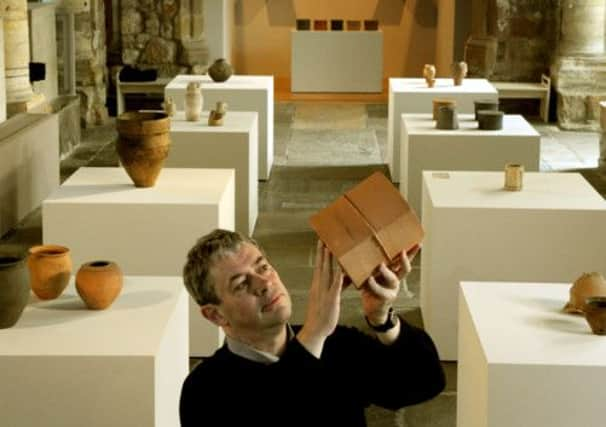Dying art reveals body of evidence


“Historical precedents have always been very important to me,” says potter Julian Stair whose new exhibition The Matter of Life and Death opens at York St Mary’s today. “What any artist does is to explore ideas that are relevant to the period they live in, but on a historical platform.”
The theme of the exhibition is the life-affirming nature of rituals of death and their place in history, with the installation featuring archeological objects from the York Museums Trust collections and Stair’s own pieces made in response to them.
Advertisement
Hide AdAdvertisement
Hide Ad“I have always spent a lot of time in museums, so this installation is about the meeting of the contemporary and historic,” says Stair. “York has the most incredible collection and I have been looking at ways in which different cultures have made objects for the body in death.”
The installation is a counterpart to Stair’s touring show, Quietus, which opened at the National Museum of Wales in Cardiff last month and features a collection of the artist’s funerary vessels which range from small jars to monumental life-size sarcophagi. The setting of this latest show in a deconsecrated medieval church seems particularly apt. “It is a beautiful space,” says Stair. “The fact that it has been at the centre of these rites of passage means that it has huge resonance.”
The show came about partly through Stair’s research post at the University of Westminster and his involvement in an academic project funded by the Arts and Humanities Research Council entitled Ceramics in the Expanded Field: Behind the Scenes at the Museum. The purpose of the project is to examine the increase in the number of artists who are making work in relation to museum collections – either using collections as inspiration or through artistic interventions within museums. “The underlying themes are that there is more than one way to relate to museum collections,” says Stair. “The University of Westminster and the York Museums Trust have an empathy of approach – it was a wonderful happenstance.”
Stair says he has enjoyed looking through the trust’s archaeological stores which cover a span of around 4,000 years. His discoveries include a Neolithic pot which would hold the ashes of someone after cremation, a small Early Bronze Age funerary jar, Egyptian canopic jars used for holding organs that had particular meaning within their culture, and a casket made to bring the heart of a person who died in Europe back home. The Romans tended to reuse their cooking pots as cremation vessels.
Advertisement
Hide AdAdvertisement
Hide Ad“They would gather up the ashes and put them in something that was in daily use to sustain us in life,” says Stair. “There is something poetic and very moving about that.” One of his most exciting finds was a Roman gypsum burial. “The body was wrapped in a shroud, put into a sarcophagus and then plaster was poured in,” he says. “We are exhibiting one where you can see the negative shape of the body that was in the plaster around 2,000 years ago.” Stair’s works in response to these objects also range in size and use a variety of materials, including stoneware, brick and clay.
“I don’t want people to see this as a morbid subject,” he says. “When someone dies who we are very fond of, these rituals become very significant. It is about making the objects and matter of death into a celebration of the person who has died.”
The Matter of Life and Death, York St Mary’s, May 10-July 7.
Potter, writer and academic
Julian Stair was born in Bristol in 1955. He studied at Camberwell School of Art (1974-78) and the Royal College of Art (1978-81), where he also completed a Phd in 2002. His work celebrates the social, cultural and multi-sensory aspects of pottery and is known for its subtle palette of greys, reds and white as well as its range of scale – from the domestic to the monumental. He is a fellow of the Royal Society of Arts and is a Principal Research Fellow at the University of Westminster. He has exhibited all over the world during the past 30 years including shows in New York, Munich, Paris and Tokyo.